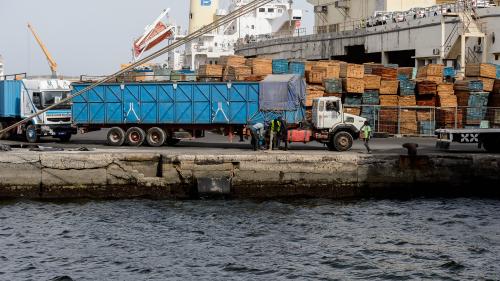In 2018, the Financial Times called the 21st century “Africa’s to lose” due to its potential for rapid economic expansion. Over the last few decades, this potential has garnered significant attention from China and Western investors and policymakers. Over this same time period, the research community shifted its attention to Africa too: Indeed, the share of peer-reviewed economics articles about Africa has more than tripled since the 1980s.
Importantly, it seems that some African countries have been the focus of more research than other ones—a lot more, in fact—according to a new paper by Middlebury Assistant Professor of Economics Obie Porteous in which he reviews all articles related to African countries published between 2000-2019 in peer-reviewed economics journals in order to assess the geographic concentration of economics research in the region. In particular, Porteous finds that 65 percent of articles published in the top five economics journals (the American Economic Review, Econometrica, the Journal of the Political Economy, The Quarterly Journal of Economics, and the Review of Economic Studies) and 45 percent of all articles published in economics journals during this time focus on just five countries (Kenya, South Africa, Ghana, Uganda, and Malawi), which account for only 16 percent of Africa’s population. In comparison, a group of seven countries—Sudan, the Democratic Republic of the Congo, Angola, Somalia, Guinea, Chad, and South Sudan—have the same combined population but account for just 4.7 percent of articles in top-five publications and 3.5 percent of all articles. Figure 1 depicts the distribution of total and per capita research articles by African nation.
Figure 1. Total research articles (left) and research articles per capita (right)
Source: Porteous (2020), “Research and Oases: Evidence from 27 thousand economics journal articles on Africa”
Note: Maps are color coded by quantiles (27 with two countries in each) and represent the tally of articles from all 1,980 EconLit journals. The color scale ranges from dark blue for the lowest tally to dark red for the highest. The per capita tally is calculated using average annual population data for 2000-2019.
Porteous also seeks to explain the variation in the number of peer-reviewed articles across countries, as, he says, population alone can explain 60 percent of the unequal distribution. He then considers three additional variables—a country’s rank on the Global Peace Index, a country’s number of international tourist arrivals, and whether or not the country has English as an official language—and states that the combination of these variables can explain 91 percent of the distribution. Notably, Porteous finds that these variables are highly relevant to the concentration of research regardless of whether the authors belong to an African institution or an institution outside Africa. In fact, international tourist arrivals can better explain the country-level variation in the number of journal articles written by authors at African institutions, a fact which Porteous surmises reflects the “overall level of engagement with the international community.”
Table 1 contains the number of peer-reviewed journal articles by journal ranking (determined by citations per article) and the proportion of which are authored by those at African institutions (referred to as “African authors”). The proportion varies widely by country: 73 percent of all economics articles on South Africa are written by African authors, whereas only 9 percent of articles on Madagascar are written by African authors. The table also reinforces that while population is the most salient determinant of the number of journal articles, there are contexts, such as the Democratic Republic of the Congo, where conducting research is hard despite the great population, even for African authors.
Table 1. Economics journal articles on African countries, 2000–2019
| Country | All Journals | Top 200 | Top 10 Dev. Journals | Top 5 | Percent African Author |
| South Africa | 5463 | 765 | 263 | 18 | 73% |
| Nigeria | 2620 | 280 | 110 | 5 | 72% |
| Ghana | 1686 | 419 | 230 | 10 | 49% |
| Kenya | 1497 | 525 | 211 | 36 | 40% |
| Ethiopia | 1239 | 561 | 281 | 4 | 34% |
| Tunisia | 1119 | 105 | 24 | 1 | 72% |
| Egypt | 1046 | 172 | 47 | 4 | 38% |
| Uganda | 1009 | 410 | 237 | 11 | 30% |
| Tanzania | 987 | 383 | 198 | 10 | 29% |
| Malawi | 604 | 262 | 118 | 9 | 32% |
| Morocco | 576 | 87 | 22 | 1 | 38% |
| Zimbabwe | 552 | 139 | 82 | 2 | 55% |
| Cameroon | 462 | 82 | 37 | 0 | 60% |
| Zambia | 435 | 164 | 71 | 4 | 35% |
| Algeria | 393 | 35 | 4 | 1 | 57% |
| Senegal | 374 | 108 | 62 | 0 | 24% |
| Mozambique | 370 | 135 | 61 | 0 | 22% |
| Burkina Faso | 319 | 117 | 63 | 0 | 29% |
| Rwanda | 303 | 91 | 52 | 3 | 17% |
| Botswana | 294 | 38 | 17 | 0 | 65% |
| Ivory Coast | 254 | 81 | 45 | 2 | 34% |
| Madagascar | 242 | 102 | 59 | 0 | 9% |
| Mali | 233 | 82 | 48 | 1 | 14% |
| Sudan | 231 | 32 | 12 | 0 | 24% |
| D.R. Congo | 212 | 35 | 15 | 5 | 18% |
| Mauritius | 206 | 26 | 14 | 1 | 72% |
| Benin | 182 | 61 | 32 | 1 | 33% |
| Namibia | 165 | 20 | 4 | 0 | 48% |
| Sierra Leone | 162 | 36 | 15 | 5 | 17% |
| Niger | 151 | 62 | 31 | 1 | 28% |
| Angola | 122 | 15 | 3 | 1 | 16% |
| Lesotho | 109 | 18 | 11 | 0 | 58% |
| Somalia | 102 | 17 | 6 | 0 | 6% |
| Libya | 99 | 11 | 2 | 1 | 29% |
| Liberia | 92 | 29 | 13 | 2 | 12% |
| Congo | 79 | 16 | 8 | 0 | 24% |
| Burundi | 77 | 25 | 15 | 1 | 13% |
| Togo | 67 | 10 | 7 | 0 | 47% |
| Eritrea | 66 | 9 | 5 | 0 | 31% |
| Guinea | 61 | 10 | 4 | 0 | 19% |
| Swaziland | 58 | 11 | 8 | 0 | 67% |
| Gambia | 57 | 18 | 9 | 0 | 32% |
| Chad | 42 | 10 | 4 | 0 | 19% |
| Mauritania | 32 | 8 | 4 | 1 | 14% |
| Gabon | 28 | 7 | 5 | 0 | 52% |
| Cape Verde | 26 | 4 | 3 | 0 | 9% |
| Central African Rep. | 20 | 2 | 0 | 0 | 24% |
| Seychelles | 18 | 6 | 1 | 0 | 8% |
| Guinea-Bissau | 13 | 2 | 1 | 0 | 11% |
| South Sudan | 11 | 1 | 0 | 0 | 20% |
| Djibouti | 8 | 3 | 2 | 0 | 0% |
| Sao Tome and Pr. | 8 | 2 | 1 | 0 | 0% |
| Equatorial Guinea | 5 | 0 | 0 | 0 | 0% |
| Comoros | 1 | 0 | 0 | 0 | 0% |
Source: Porteous (2020), “Research and Oases: Evidence from 27 thousand economics journal articles on Africa”
Demand from under-researched countries for context-specific evidence outstrips the supply of such evidence in many African nations, but it is an expensive gap to close. The author concludes the paper by modeling the costs and benefits to conducting research in Africa, exploring whether factors like previous research or development aid make research uptake more appealing, and suggests eliminating impediments to access or collect data as a feasible short-run solution to improving the evidence base in under-represented countries.
The Brookings Institution is committed to quality, independence, and impact.
We are supported by a diverse array of funders. In line with our values and policies, each Brookings publication represents the sole views of its author(s).








Commentary
Figure of the week: Economics research on Africa is not evenly distributed across countries
September 11, 2020